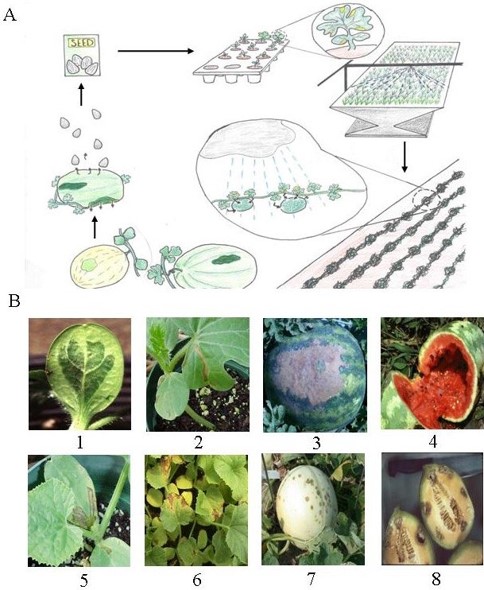Elucidating virulence mechanisms of bacterial canker disease in tomato and pepper
The Gram-positive bacteria, Clavibacter michiganensis and Clavibacter capsici, cause bacterial canker diseases in tomatoes and peppers, resulting in significant crop losses. These pathogens are seed-borne. Once they infect the plants, they spread through the xylem, causing cankers or wilting. Unlike Gram-negative bacteria, these pathogens lack the type III secretion system. Instead, these pathogens can use the type II secretion system to secrete enzymes such as cellulases and serine proteases into the apoplast as key virulence factors. Our laboratory is conducting several studies to elucidate the virulence genes and virulence mechanisms of Clavibacter species. Ultimately, we aim to establish a model system to study the interaction between Gram-positive plant pathogenic bacteria and host plants.


Studying on virulence and avirulence functions of type III effectors of Acidovorax citrulli
Acidovorax citrulli, the causal agent of Bacterial Fruit Blotch on melon and watermelon, delivers type III effectors (T3Es) into plant cells via the type III secretion system. These T3Es play a critical role in facilitating colonization and disease development in susceptible host plants and at the same time can be recognized by plant NLR proteins, triggering immune responses and hypersensitive responses in resistant host plants and non-host plants. Despite of the important role of T3Es in virulence and avirulence, there has been only limited research on the in planta recognition of A. citrulli T3Es and their contribution to the interaction with plants. We are investigating their functions in virulence and avirulence.
Elucidating infection pathways and the role of virulence factors in infection processes
Plant pathogenic bacteria generally invade the host plants through multiple pathways, including the wounded tissues, natural openings such as stomata, and insect vectors. Among these, we are investigating how plant pathogenic bacteria, including Clavibacter species, enter the xylem of host plants through the roots and proliferate in the xylem vessels. Ultimately, we aim to identify the targets and roles of key virulence factors that are important during infection to elucidate the disease development in host plants.


Managing bacterial plant diseases with bacteriophages
Bacterial plant diseases are typically controlled with chemicals such as antibiotics and copper-based pesticides. However, the overuse/misuse of these materials has led to the emergence of antimicrobial resistance (AMR). This has created a demand for the use of safer and more environmentally friendly biological agents, and the development of novel antimicrobial agents is necessary. Bacteriophages are viruses that specifically target and kill their host bacteria. We are investigating the use of bacteriophages to control bacterial plant pathogens, such as Erwinia amylovora and Pectobacterium spp., using bacteriophages. We are also studying endolysins, phage-encoded peptidoglycan hydrolases.
Developing sensitive diagnostic tools for fire blight
Fire blight is a devastating plant disease that can easily spread throughout an orchard, requiring the removal of all infected apple trees to prevent further spread. Conventional detection methods, including PCR, ELISA, and lateral flow devices, have been used to minimize the damage caused by fire blight disease. However, these methods have limitations such as low sensitivity and post-mortem detection. To overcome these limitations, we are developing a novel diagnostic tool using bacteriophages with high specificity and sensitivity. We have isolated Erwinia amylovora-specific bacteriophages and engineered their genomes to insert reporter genes. In addition, we are also studying phage tail proteins to use them as materials for various sensors.

